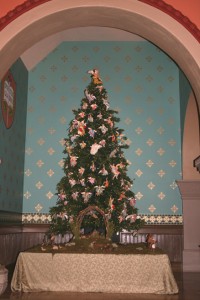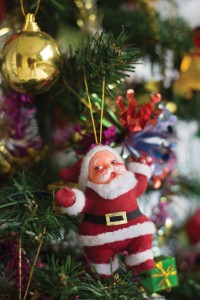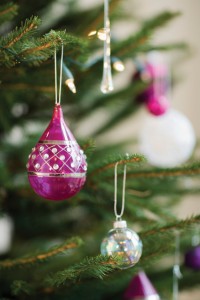O Tannenbaum! Tips for Holiday Trees
 Forget politics and religion: if you want to stir things up at your next holiday party, bring up the subject of Christmas trees. Everyone’s got an opinion. There’s the staunch “real tree, white lights” set, the smooth-talking “faux’s the way to go” advocates…not to mention other arguables like ornament placement, light stringing techniques, garland versus tinsel (or not). Even within families, there is likely to be a debate over whose way is the right way.
Forget politics and religion: if you want to stir things up at your next holiday party, bring up the subject of Christmas trees. Everyone’s got an opinion. There’s the staunch “real tree, white lights” set, the smooth-talking “faux’s the way to go” advocates…not to mention other arguables like ornament placement, light stringing techniques, garland versus tinsel (or not). Even within families, there is likely to be a debate over whose way is the right way.
But that’s the beautiful thing about Christmas trees: there is no right or wrong way, not really. It’s the act of putting up the tree that counts, of creating a holiday tableau around which other traditions are centered, literally and figuratively. But traditions can get stale if we don’t evaluate what we’re doing every now and then. This year, when putting up your Christmas tree, keep a few considerations in mind so the chore doesn’t outweigh the cheer. Perhaps a little knowledge and perspective might add a new dash of fun to your tree traditions.
 Real Versus Faux
Real Versus Faux
According to the American Christmas Tree Association, there is no debate on this one: both fresh and artificial trees have their merits, and the group’s recent study showed that neither has a significantly different impact on the environment. So if we take environmental considerations off the table, and know the pros and cons of each (those that have been argued in families and at cocktail parties), you’ll just have to go with what works for your family and your season.
If you’re buying a live tree this year, take the time to examine it for freshness so you can get a good four weeks out of it. If it’s encased in netting as many are at the tree lot, ask an employee to help remove it. Run your hand over the branches; if needles drop, move on to the next tree. Branches should feel supple and pliable. Also, if a tree feels lighter than it should, that’s a sign that the tree may be dried out—over half of the weight of a tree is water. Though prices vary, you can expect to pay about $10 per foot for a fresh tree, give or take.
If you’re purchasing an artificial tree, consider it a multi-year investment and buy the best you can afford for the most pleasing results. The price for an artificial tree can range anywhere from two digits (mini and novelty trees) all the way up to four digits, and there are many things to consider: size, color, lights, density of branches and more. You should not be able to see the center pole on a quality artificial tree, and if you choose a prelit tree, make sure it has enough lights to suit your taste.
 Securing the Tree
Securing the Tree
Most of us have “the spot” in our home where we place the tree, year after year. Maybe it’s displayed in a street-facing window in the formal living room, or tucked in a corner of the den where the family likes to congregate. Pick the place where you’ll get the most enjoyment out of it. If you’re considering shaking things up this year and relocating the tree—or better yet, adding another to your decorating scheme—be sure to measure your ceiling height so you know your tree will fit, and don’t forget to take into consideration both the height of the tree stand and your tree topper. Make sure you place it near an electrical outlet, but away from air ducts that will dry out a live tree. Keep both real and artificial trees away from fireplaces to avoid a fire hazard. Consider too, giving the tree enough berth so it doesn’t brush against drapes or scratch the paint on the wall. Don’t be afraid to move the furniture to accommodate your tree—that’s half the fun, having a great excuse to enjoy a new furniture layout for a few weeks
of the year.
 Wherever you place it, make sure it’s sturdy and level before you begin to decorate it. We all have or have heard the heartbreaking stories of tree collapse and broken heirloom ornaments. Start by assessing your tree stand; make sure it’s designed to hold a tree of the size you come home with. Take another line of defense with this trick: secure your tree to the wall or ceiling with a length of fishing line and a small screw hook. Got toddlers or pets? Here’s another trick: place your tree, not your children, in the play-yard, to avoid curious hands. Also don’t forget to place a small tarp under your fresh tree to avoid discovering water damage on the floor come January.
Wherever you place it, make sure it’s sturdy and level before you begin to decorate it. We all have or have heard the heartbreaking stories of tree collapse and broken heirloom ornaments. Start by assessing your tree stand; make sure it’s designed to hold a tree of the size you come home with. Take another line of defense with this trick: secure your tree to the wall or ceiling with a length of fishing line and a small screw hook. Got toddlers or pets? Here’s another trick: place your tree, not your children, in the play-yard, to avoid curious hands. Also don’t forget to place a small tarp under your fresh tree to avoid discovering water damage on the floor come January.
 Trimmings and Trappings
Trimmings and Trappings
Trimming the tree is supposed to be fun! But burnt-out lights, garland shortage, and arguing over ornament placement can all spark ire in this process. Consider these tips for stress-free tree trimming. First, keep strands of lights plugged in as you work; it’s easier to see what you’re doing and you’ll know if all are in good working order. Decorate from the inside out, working from the trunk to the outer layers, and from top to bottom. Your taste dictates just how bright you want your tree to be, but a good rule of thumb is to use about 100 lights for about every foot of your tree. But don’t string more than three strands on one electrical circuit to avoid overload.
 There are a number of ways to string those lights. The traditional wave pattern—wrapping around the tree maypole-style—is probably the fastest and easiest. Another way is to mentally divide it into three triangular sections, from top to bottom, around the cone of the tree. Starting at the top, weave lights back and forth across that triangle all the way to the bottom of the tree, then repeat this process in the other two triangles. For the most meticulous of tree trimmers, there’s the branch wrapping method—wrapping each branch for a real glow-from-within look.
There are a number of ways to string those lights. The traditional wave pattern—wrapping around the tree maypole-style—is probably the fastest and easiest. Another way is to mentally divide it into three triangular sections, from top to bottom, around the cone of the tree. Starting at the top, weave lights back and forth across that triangle all the way to the bottom of the tree, then repeat this process in the other two triangles. For the most meticulous of tree trimmers, there’s the branch wrapping method—wrapping each branch for a real glow-from-within look.
Next comes the garland, if you are so inclined. You’ll need about nine feet of garland per foot of tree. It’s best hung gently swagged—or use it vertically, twisting down from the tree topper.
 And Then, The Ornaments
And Then, The Ornaments
Retailers provide us great inspiration to bedeck our trees with carefully coordinated ornaments. But many of us also have salt dough and clothespin ornaments from seasons past that are among the most cherished. For the best of both worlds, consider one unifying element on your tree—say, simple glass ball ornaments in a color you love—and fill in with your treasures. Or consider incorporating another, smaller tree in a different location and deem that your “decorator tree” to do with what you choose. Think candy-themed ornaments on a mini-tree on the kitchen island, or bold and elegant metallics (glass balls, faux flowers) on a tall, thin tree tucked in the corner of the dining room where you’ll be entertaining.
When trimming the tree, perhaps the best tip of all is to dim the lights, step back and take in the big picture to assess your work in progress. Sometimes you need that perspective to see what areas need work, and what is really beautiful from the right distance. And really, isn’t that great advice for the whole season?
Christmas Ornaments, Christmas Trees, Fake Christmas Tree, String of lights, Trimming the Tree






